Breeders are constantly working to introduce new breeds of aquarium fish to the world. This activity is very painstaking: it is necessary to identify new interesting traits, carry out numerous crosses and select the best individuals in order to consolidate the trait. Changes can relate to the shape of the body, size, but most often they manipulate the color of the fish, sometimes getting an incredible play of color. The blue scalar form is a prime example of this. How difficult it is to keep such a beautiful fish at home, you will learn from our article.
General information
A blue scalar is a selection from the common scalar (Pterophyllum scalare). Its main difference from other breeds is the delicate blue color of the body and fins. The fish looks great in aquariums with a large number of living plants, its scales are able to reflect even small beams of light, making the scalar “glow” blue.
When the first representatives of the breed appeared on the market, many believed that it was just an ordinary scalar, artificially colored blue. But in fact, this breed is the fruit of the works of the famous breeder Ken Kennedy, who lives in the Philippines.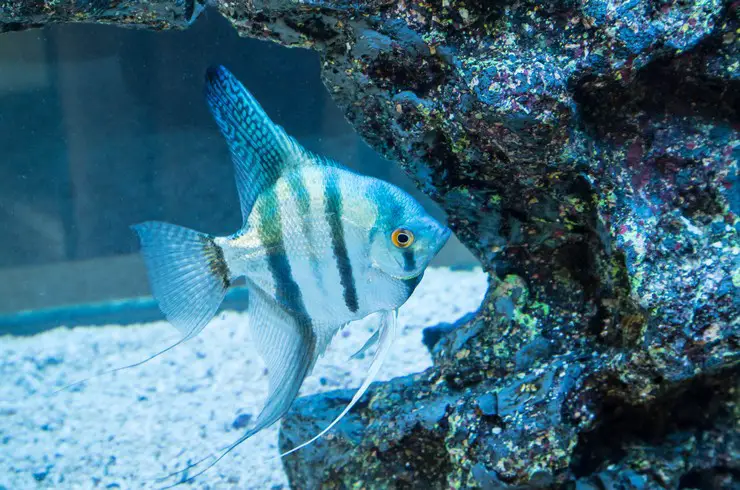
For a long time, he was engaged in the selection of platinum scalars and noted in some individuals an interesting combination of blue and gold color genes. Through a huge number of crosses, he managed to consolidate a stable blue color, and the new gene was named “Philippine Blue”. The first blue scalar was sold in the United States, the most famous form being the Pino scalar – a dark fish with a blue gene. Currently, there are many more variations of a scalar with a blue gene.
The content of blue scalars is no different from the content of any other breed of this species. This graceful fish will undoubtedly become a decoration for any large aquarium.
Appearance
The blue scalar has a body shape characteristic of all scalars. It is flattened laterally; the anal and dorsal fins are strongly elongated. The overall profile resembles a triangle or crescent. The maximum body size is 15 cm in length, the height due to the fins can reach 20-25 cm.
The terminal rays of the caudal fin and the pectoral fins are filiform. The mouth is small, the eyes are large. This body shape allows natural forms to hide perfectly among thickets of dense vegetation.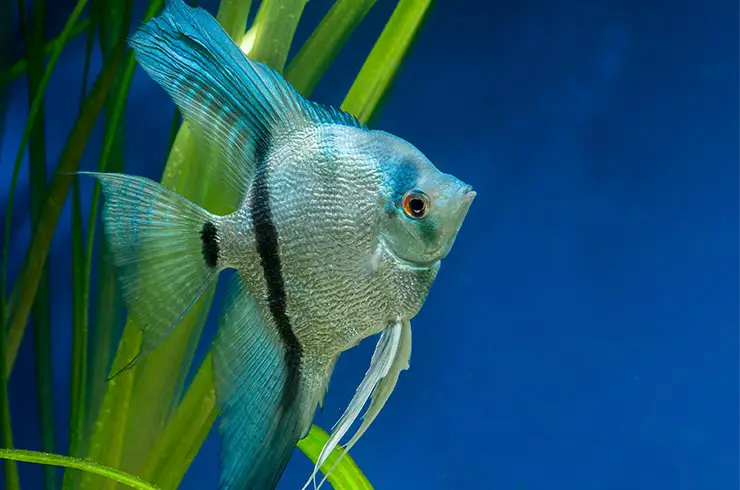
The color of blue scalars is varied. It can be plain blue, as well as with black transverse stripes characteristic of many types of scalars, expressed to one degree or another. But the main color of the scales still remains pale blue, often with a rainbow effect, when the incident rays of light are bizarrely reflected in it.
Habitat
It is not possible to meet blue scalars in nature. This is a selective species that was artificially bred by humans. In a natural environment, fish with a similar color would be quickly destroyed by predators.
The homeland of natural forms of scalars is the tropical rivers of South America – the Amazon and Orinoco. Usually fish live in small creeks with a sandy bottom and dense thickets of plants. The water in these reservoirs is soft and acidic, which must be taken into account when keeping, including blue scalars.
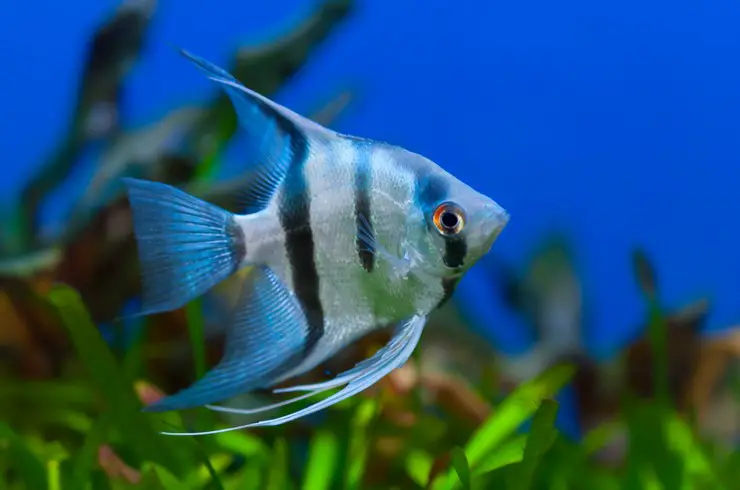
Care and maintenance
Blue scalars are fish that love space, therefore, to keep a couple of fish, it is better to choose aquariums with a volume of at least 80 liters and a height of 50-60 cm. You can settle a scalar in pairs, but they look best in small groups of 6-8 individuals.
An aquarium decorated in a natural style will be most suitable for scalars. Sand or small pebbles are used as soil. The scalars do not dig in the ground, making them excellent candidates for keeping with live plants. And here the choice of species is limited only by fantasy. Long-stemmed, broadleaf, floating, and groundcover species can be used. Well-fed blue scalars are practically indifferent to greens, only occasionally can they pinch off a tender shoot. But it is important to leave the fish and space for free swimming in order to admire them in all their glory.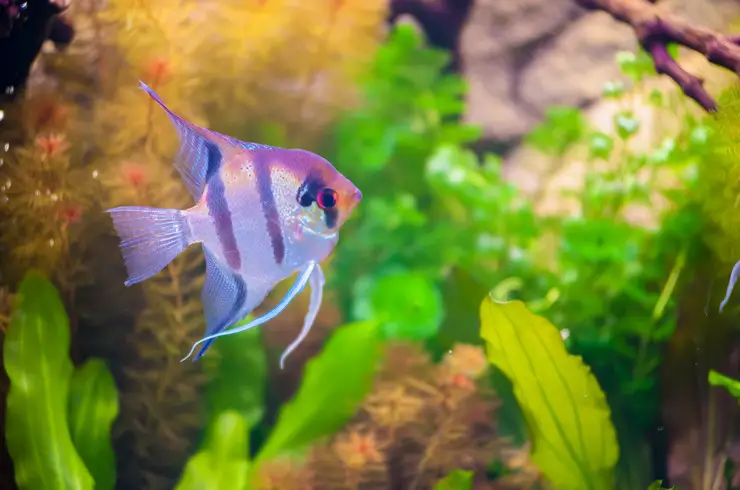
Natural driftwood and stones are ideal as decorations, from which you can create whimsical and always unique compositions.
Aquariums with blue angelfish need to maintain high water quality. For this, the tank must be equipped with a productive external filter and a high-quality compressor. To maintain a comfortable temperature, you need a thermostat. 20% of the water is changed in the aquarium weekly.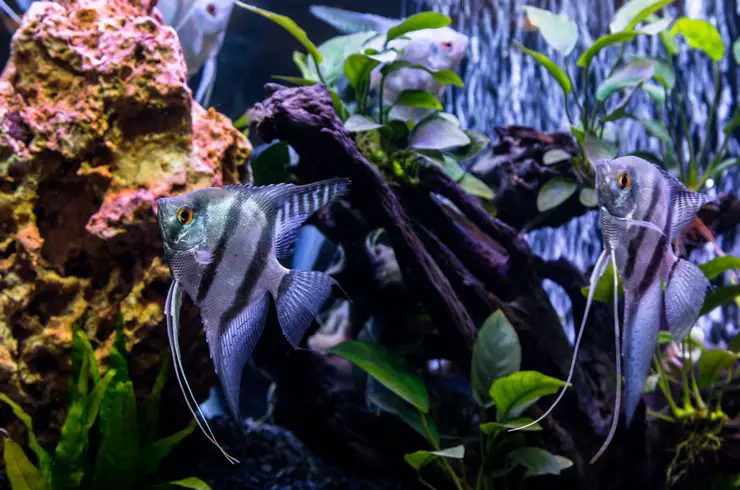
Compatibility
Blue angelfish are an excellent choice for keeping in shared aquariums. They prefer to swim in the middle layers of the water and get along well with the most popular tropical fish species. It will not be difficult to find neighbors for scalars: viviparous fish (mollies, swordtails), labyrinths – lalius, gourami, irises, neons, large tetras, peaceful catfish (corridors, ancistrus). Almost any calm fish, the size of which in adulthood is more than 4 cm, will do, since fry or very small species, unfortunately, can become a victim of this calm, but still a predator.
But with goldfish, as well as large aggressive species, it is better to exclude cohabitation. Active barbs, which sometimes do not mind plucking the filamentous fins of scalars, will not be the best neighbors.
Feeding Blue Angelfish
Blue angelfish do not belong to gourmet fish and, when kept at home, they perfectly eat various types of food. However, for a number of reasons, the use of live and frozen food is not recommended: they do not contain the full range of nutrients necessary for fish, and in themselves are potential sources of contamination of the aquarium with dangerous infections. The optimal choice would be to feed blue scalars with high-quality dry food, which is completely devoid of the disadvantages of live and frozen food.
They prefer to take food from the surface of the water, so flakes and chips will be the most suitable form:
- TetraMin is a universal flake food for all tropical fish. It is made from more than 40 types of raw materials and is perfect for the daily nutrition of fish. The flakes stay on the surface for a long time, after which they slowly sink to the bottom.
- TetraPro is a high-quality crisp food for all types of tropical fish, made using gentle low-temperature technology. They have increased nutritional value and assimilation. Contains functional additives such as Spirulina Concentrate (TetraPro Algae), which will fully satisfy the plant food requirement of Blue Angelfish, or an additional source of energy (TetraPro Energy) to make your pets even more active.
- For a change, it is very useful to introduce into the diet natural treats Tetra FreshDelica – these are traditional food organisms (bloodworms, daphnia, brine shrimp, krill) in nutritious jelly that your blue angelfish will definitely love.
Reproduction and breeding
To breed blue scalars, you will need a separate spawning container with a volume of 80 liters or more. Plant a few bushes of plants with wide leaves, such as Echinodorus or Cryptocoryne, in the aquarium. They will be an excellent spawning substrate. You can also use a thin glass or plastic plate.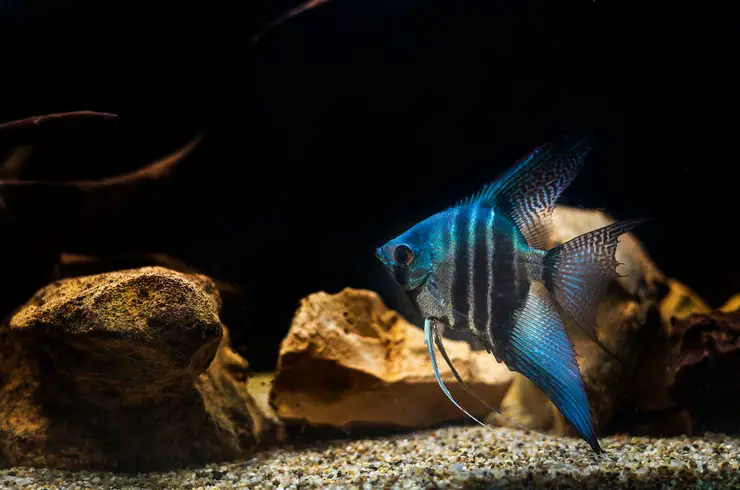
Spawning is stimulated by an increase in temperature to 28-30 ° and more, as well as frequent water changes.
When the couple is ready to spawn, the parents clean the area of dirt and mucus, after which the female lays rows of small eggs, and the male fertilizes them. The fecundity of the female is 400-500 eggs. Blue scalars are caring parents. Male and female fan the clutch with fins, remove dead eggs.
Two days after spawning, larvae hatch from the eggs, which after a week begin to move and feed on their own. The fry is sensitive to the purity of the water, so at first, more frequent changes and removal of uneaten food are necessary. The fish grow rather quickly. Blue angelfish reach puberty at the age of 8-12 months.
